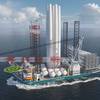The changeover to 2000 means many things to many people, on both a personal and professional level, as the end of the millennium serves as a handy measuring stick against which achievements can be measured. But, potential Y2K problems aside, for the maritime industry the strike of midnight on December 31, 1999 will mean nothing more and nothing less than any other measure of time.
The manner in which boats and ships are designed, built, outfitted and operated has changed rather dramatically during the past decade. Everything from the advent of powerful computing hardware and software — both maritime specific and general business — to sweeping consolidation on the vessel building, vessel owning and marine equipment manufacture side has drastically altered the traditional maritime landscape. Advancing technology and consolidation have been recurring themes in the pages of Maritime Reporter & Engineering News for many years, but it was perhaps the recent Europort exhibition in Amsterdam that truly drove both points directly home. The proliferation of truly revolutionary marine products and systems — such as the industry's first type approved ECDIS systems from both Transas and Kelvin Hughes — is astounding. Similarly amazing is the sheer size of some of the industry's leading companies, as well-known manufacturers as Litton and Wärtsilä NSD now incorporate products and systems acquired through often aggressive acquisitions.
Yet through the constant turmoil, the maritime industry remains hauntingly the same. This is not a swipe at the industry's traditionally held conservative nature, rather a tribute to an industry, which is virtually incapable of becoming obsolete. While the economics, logistics and technology of the maritime business will continue to change, sometimes dramatically, it is a safe bet that in this generation there will be no manner in which products will be moved more efficiently from point A to point B than via ships and boats. This is not to say that radical changes will not be incorporated. The rapid progression toward the building of the new gas turbine powered FastShips — as well as a surge of orders for fleets of newer, larger, faster passenger vessels — are signs that the "need for speed" will continue to grow, driving development in all industries, including maritime.
While the trend is toward consolidation in all sectors, and while deep corporate pockets and capabilities are particularly welcome when the time comes to set and spend the R&D budget, medium and small-sized players maintain an enviable position, in part because smaller companies are sometimes more flexible and adept at providing immediate, customer-mandated solutions for the business opportunities du jour. One of the keys to success for any maritime company of any size in 2000 and beyond is gaining more market sector knowledge and savvy, while carefully monitoring the effects of expansion as compared to a company's overall goals.
Subscribe for
Maritime Reporter E-News
Maritime Reporter E-News is the maritime industry's largest circulation and most authoritative ENews Service, delivered to your Email five times per week










